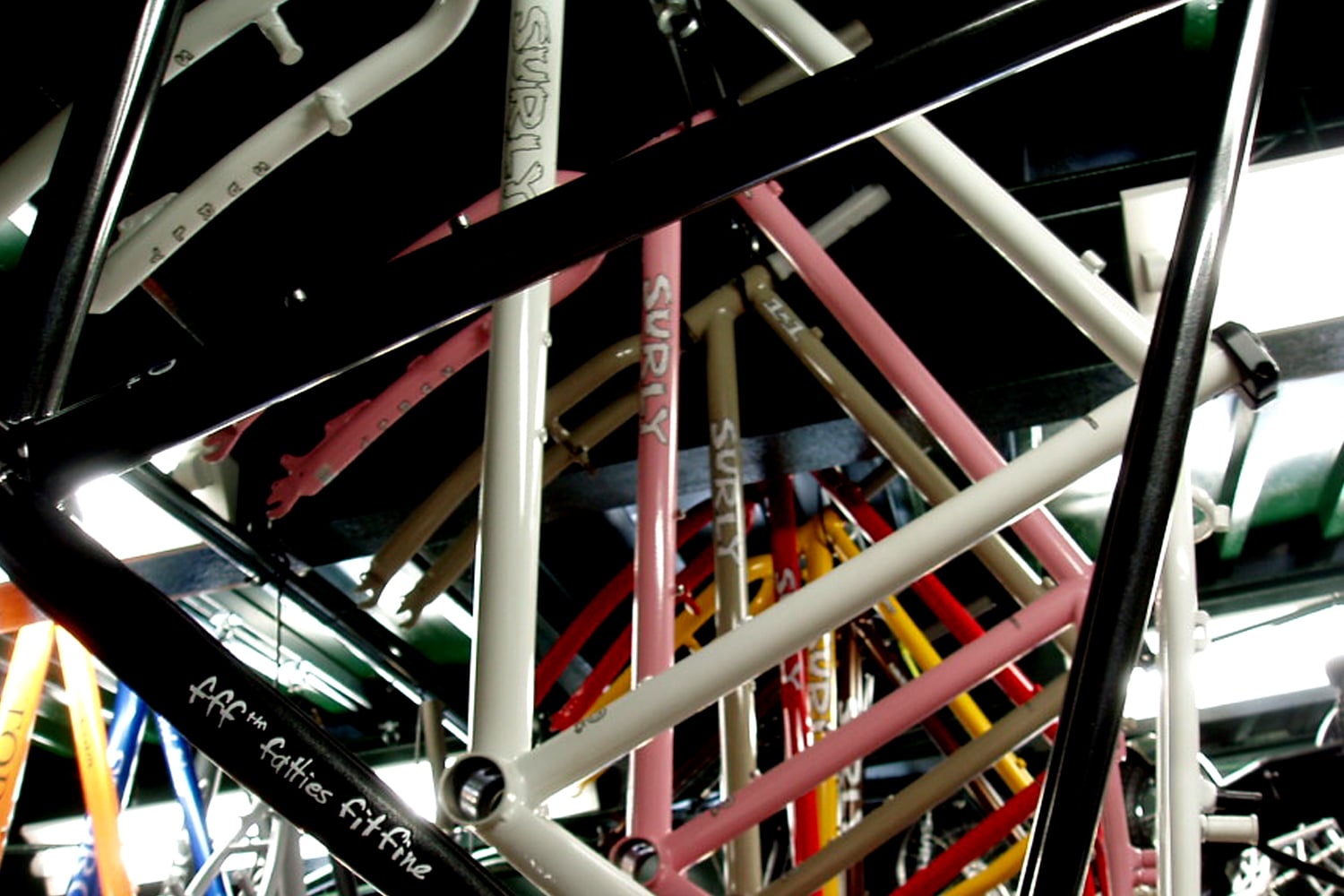A few weeks ago our art director, A-Wood, brought a knife by my desk. Apprehensive that things were about to get real, I was relieved when he calmly asked if I would sharpen it for him. The blade belonged to his grandfather. Made in Norway some years ago, it looked to be a well used heirloom. He said he was in no hurry to have it back, so I accepted. It sat on my workbench in the garage where I'd survey it now and again. Usually while sipping a beer and considering how and when I'd tackle the job. Today was the day to renew the edge on this classic Brusletto hunting blade.

Wait. A blog about knife sharpening? "How the hell did we get here?" you may be asking. Follow me to the wayback machine for a minute …
My dad let me play with knives and axes at far too young an age (at least according to a lot of other adult family members at the time). The countless cuts and all the spilt blood of my youth did not deter me. I have appreciated edge tools all my life. If it's made of steel, and has a renewable cutting edge, I have an interest in its design and purpose.
I also like to sharpen things. A lot. That's fortunate, because knives and such don't keep themselves sharp, y’know. I guess you'd call honing a hobby of sorts. A useful hobby when one considers the number of pointy things we use and rely on every day.
This verbal spew is not a tutorial, by the way. I'm the first to admit I'm no expert. I sharpened kitchen and pocket knives with nothing more than a hand-me-down whetstone until five years ago. I began intensively using hand tools for woodworking at that time, so I bought some waterstones and a couple of jigs for chisels and planes. I started reading books on theory and technique. Ooh wee, my book learnin' and sweet new gear were taking me places!
As is the case with any pursuit, however, it's entirely too easy to get sucked into dogma. For a couple of years I was afraid to sharpen freehand without jigs because I’d “mess it up.” (Nevermind the fact that was all I'd practiced for 30 years with consistently good results.)
I've gradually come around to changing up techniques for the task and tool at hand. After all, the ultimate measure of success is a blade's fitness for its purpose. (I.e. Does it cut well and hold an edge?) It’s not about what fancy fixtures and gauges one uses to get there.
(Hmm, could there be a parallel or two to cycling in here somewhere?)
But I digress. Back to Grandpa Wood’s knife!

Initial inspection revealed this knife hadn't seen a stone in a long time. The tip and belly of the blade were butter-knife dull. What honing had previously been done wasn't true to the knife’s “Scandi” grind. Scandi knives have a wide, flat bevel and are meant to be honed on that flat equally from both sides. Easy peasy, if you stick to the flat. That wasn’t the case, so the original flat needed resetting. A coarse diamond stone was the tool for the job.
Admittedly, diamond stones are kind of fancy. I held off buying one for years because they're also not cheap. However, they don't dish-out with use and nothing is better for quickly grinding out blade chips and removing metal by hand.
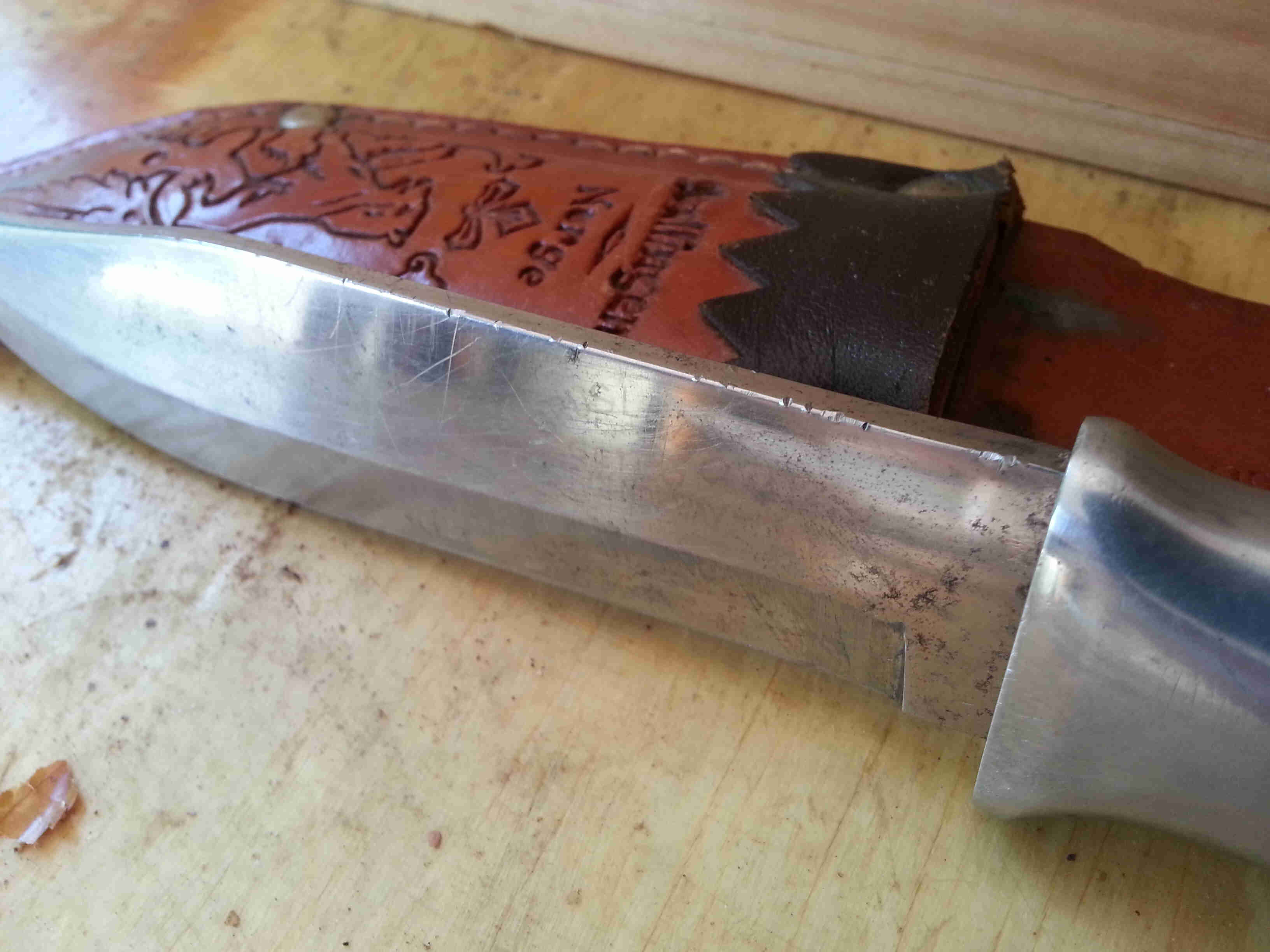
Further inspection revealed two notable things about this blade. It has a laminated construction consisting of harder steel in the middle (that helps hold the edge) and softer steel on the top and sides. Hard steel can be brittle, so the soft layer encasing it protects the blade from striking and impacts. That latter feature came in handy. The tell-tale nicks in the spine of the blade reveal it was used for knife play of some sort. Was Grandpa Wood prone to bar fights? Possible, I suppose. Most likely they are the result of swordfight-style shenanigans. While I can deduce from the nicks that Gramps was right-handed, I cannot vouch for digit retention. I'll have to ask A-Wood. About the fingers. And the bar fights.
PRO TIP: Check your ‘Highlander’ fantasies at the door, bucko. Smashing blades together destroys the knife edges of mere mortals.
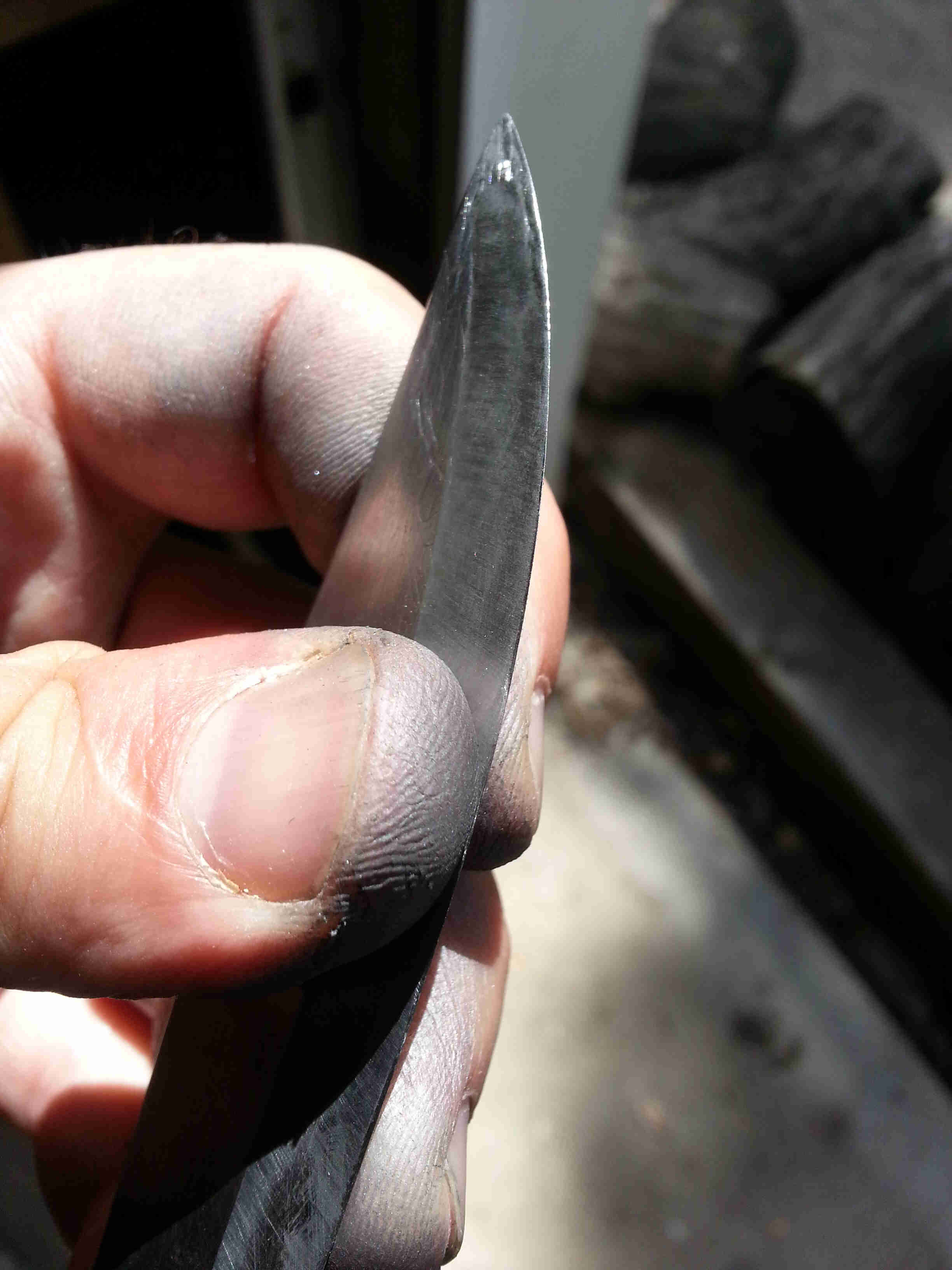
This entire process can be summed up in one pithy phrase: Honing is the pursuit of a zero radius edge. As in, the as-near-to-perfect-as-possible intersection of two uniformly ground bevels. That's it. Simple, eh? Well, getting there is the hard part. Fortunately, there are many ways to gauge progress along the way.
Lots of folks think they know what a sharp edge feels like. When executed correctly, fingertips can be useful sensors, especially when feeling for a burr (rolled metal edge that indicates it’s time to step up to the next finer grit). A safer technique involves looking for light reflections along the edge of a blade. (A zero radius will not reflect light.) In the photo above you can see just how dull this blade was. That shiny strip at the tip shouldn't be there. Below my thumb you’ll see just a few reflections where the blade was initially sharper.
Now, listen up! Don’t go running your pretty little fingers along knife blades just ‘cause some jackbait on the Surly blog said it’s okay! Got it? And quit licking windows. That’s not cool.
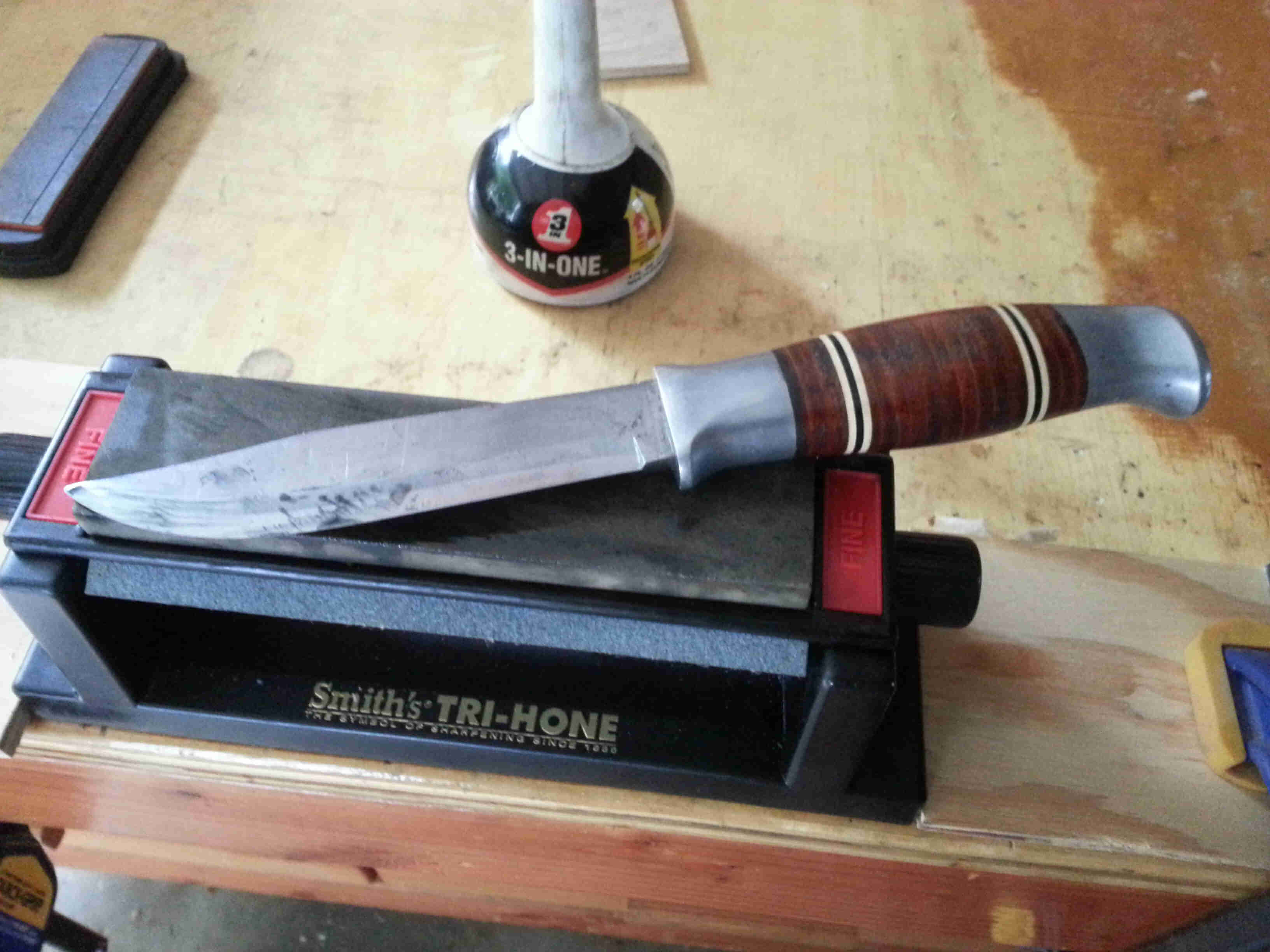
After an hour or so of resetting the bevel on the diamonds, it was time to move on to finer stones. I like oilstones for sharpening knives for two reasons: 1) I started honing on oilstones, and 2) Oilstones wear slowly which is handy given the slicing motions of sharpening a knife. Soft Arkansas refines the edge. Because this knife had gone very dull and had a rounded edge, I opted to build in a convex micro-bevel. That not only makes me sound like I know what I’m talking about, it saves excess grinding on the blade and creates a slightly reinforced cutting edge. The Hard Arkansas stone polishes out the previous stone work and creates final sharpness. Ooh, shiny!
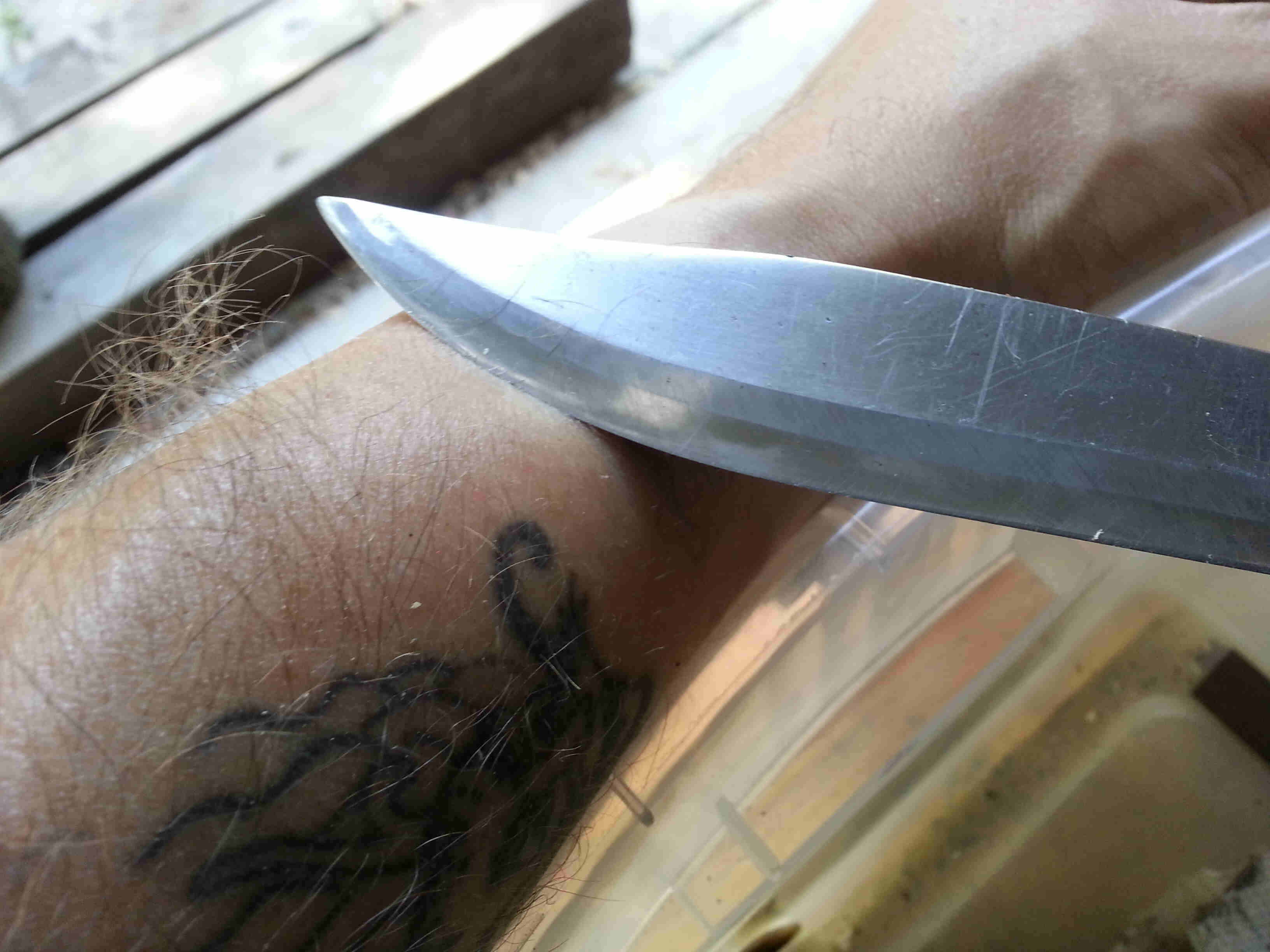
Even the lightest touch on fine stones will leave some microscopic bits of metal folded over on the knife's edge (again, that's the burr). Stropping on a strip of leather charged with a little buffing compound refines the edge even further. It's overkill on most knives. As is the shaving test. I don't shave with hunting knives, nor do I recommend it. But it can be a moderately entertaining party trick and is a decent measure of final sharpness. Plus, who doesn't appreciate crop circles of hair missing from their forearms?
In defense of stropping a general purpose blade: If a knife is made of relatively hard steel and/or is unlikely to be regularly honed, there are benefits to polishing the edge as far as is practical. It will stay sharper longer. That's because tiny imperfections in the edge invite further rolling of the burr that makes the knife dull. If you sharpen your knife frequently, this is less of an issue. Since I knew A-Wood wanted to get right down to skinning some game for a new mask project, I figured the sharper the better!
You think bike forums are full of self-proclaimed experts? You should check out a sharpening thread on a knife forum sometime. Folks love to debate steel classifications, stone grits, honing angles, wonder gizmos, and generally trash-talk each other's lack of knowledge. Bloodthirsty brutes!
Personally, I'd rather just get my edge on so I can re-commence chopping, hacking, slicing, paring, cleaving, splitting, flaying ... you get the picture. Let other people debate the minutiae. Most of it is merely a distraction anyway. Who needs more of that?
About Fleck
Meet John, Surly’s Global Sales Manager & Domestique. Long ago, John worked for Surly in a customer service and sales capacity, long before Surly had any sort of proactive sales plans or programs. Most recently however, he honed that experience by building relationships and selling bicycles and bicycle accessories to people outside the U.S. of A. He returns now with a wealth of knowledge about Surly, about the needs and habits of bike shops and about the clockwork orange that is global and domestic sales markets. John’s hobbies include woodworking, riding bicycles, positively focused skepticism, being a dad, Buddhism, making good food and eating good food.
 Surly Bikes
Surly Bikes